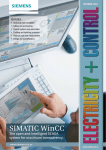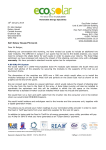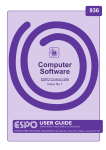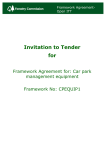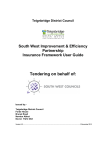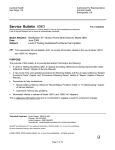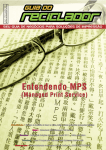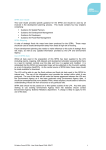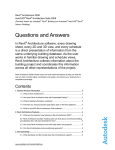Download Water and Environment Management Framework User Guide
Transcript
APPENDIX 3
Water and Environment Management Framework
User Guide
Operational instruction 410_13
What’s this
document
about?
Issued 19/06/2013
This document explains how to procure consultancy and
construction work through the Water and Environment
Management (WEM) Framework
Who does this
apply to?
All Environment Agency staff who use consultants and
contractors for engineering and environmental work.
Contents
Chapter 1: WEM Framework overview
Part 1: Cost management
2 9 Part 2: Supplier incentives
10 Part 3: Performance management
13 Part 4: Minimum technical requirements
14 Part 5: Framework management
15 Chapter 2: Using the Framework
Part 1: Procurement strategy
Doc No 410_13
Document
details
17 17 Part 2: Work allocation
20 Part 3: Contract award
21 Part 4: Managing the contract
22 Part 5: Closing the contract
23 Chapter 3: Related documents
25 Appendix 1: Services and activities by lot
26 Appendix 2: Approved suppliers by lot
32 Appendix 3: Summary of key changes to Framework
33 Version 1
Last printed 13/11/13
Related
documents
Feedback
Contact for
queries
Contact
name here
Page 1 of 33
Chapter 1: WEM Framework overview
Introduction
From 2013-2022, we intend to invest more than £2.5 billion to reduce risk
from river and coastal flooding and to secure wider environmental and social
benefits. Our professional relationships with contractors and consultants are
crucial to delivering these multiple benefits.
We need to achieve more outcomes for people and the environment with
every pound we spend. We will establish and quickly develop excellent
working relationships with our suppliers to improve performance and reduce
costs. Through the WEM Framework we will encourage innovation,
collaborative working and challenge in order to deliver sustainable outcomes.
This is described in more detail in Engineering a Better Environment Sustainable Engineering Procurement Strategy 2011 to 2020.
What is the
WEM
Framework?
Formalised in 2013, the Water and Environment Management Framework
provides access to the best suppliers in flood and coastal risk management.
The WEM Framework is a commercial agreement between the Environment
Agency, consultants and contractors ('suppliers') with agreed terms for the
award of individual contracts to deliver projects for Flood and Coastal Risk
Management (FCRM).
Who should
use the WEM
Framework?
The WEM Framework should be considered for all FCRM and other related
work types at the planning and programming stage by staff in all
Environment Agency directorates.
The framework is also available for use by Local Authorities (LAs) and, in
particular Lead Local Flood Authorities (LLFAs), as well as other Risk
Management Authorities (RMAs) in the Defra family.
Doc No 410_13
Version 1
Last printed 13/11/13
Page 2 of 33
What is the
scope of the
WEM
Framework?
The framework has been set up in four 'lots' for different types of work:
- Lot 1 Modelling, mapping and data Services
Examples include:
o Hydrological modelling and analysis
o Mapping of river and sea flooding
o Management of geographical data
- Lot 2 Environmental services
Examples include:
o Environmental Impact Assessment
o Landscape architecture design
o Heritage and archaeological management
o Ecological survey and habitat creation
- Lot 3 Engineering and related services
Examples include:
o Strategy, project appraisal and feasibility studies
o Design, supervision and contract management
o Specialist engineering such as design of flood gates.
o Research and development
- Lot 4 Asset delivery
Examples include:
o Construction works
o Coastal works such as; beach nourishment, dredging, coastal
structures
o Design and build
Services and
activities by
lot
See Appendix 1 for a full description of services and activities by lot
Approved
framework
suppliers
Appendix 2 lists the approved suppliers for each lot. Note that in Lot 4,
suppliers can only be selected for the regions shown in the table for lot 4.
How were
suppliers
selected?
Suppliers on the WEM Framework were selected because they have
demonstrated capability. Each supplier has agreed rates for staff and / or
principal construction operations that will be used as a cap for each
commission.
These suppliers demonstrate class leading safety and employee welfare and
commitment to sustainability, going beyond what is mandatory to be the best
in the industry. They demonstrate they strive to improve at every opportunity.
Each of our suppliers has an integrated supply chain and offers a 'one stop
shop' for the services they provide. Supply chains are already in place,
providing specialist services at agreed rates as well as general services.
Key changes
Doc No 410_13
Appendix 3 lists the key changes in the WEM Framework compared to earlier
generations of frameworks used by the Environment Agency for flood and
coastal risk management.
Version 1
Last printed 13/11/13
Page 3 of 33
What are the
benefits of the
WEM
Framework?
The principal benefits of framework contracts are:
Efficiency
savings
Long term relationships - the client and suppliers commit to work in
partnership for 4+ years, providing stability for both parties and
consistent project delivery throughout the period.
Efficiency savings through the procurement process - framework
suppliers form a pre-qualified shortlist for individual contracts to be
awarded by competitive tender. This maintains competitive tension
whilst embracing a streamlined tender process that is quicker and
more efficient for both parties.
Delivering programmes of work in the right way will maximise
efficiency gains for the Environment Agency. Packaging of projects
into programmes of work offers suppliers continuity of work and
provides an increased opportunity for standardisation, innovation and
delivery of sustainable outcomes.
Performance management; the Environment Agency tracks
performance indicators and reports on supplier and project
performance to identify areas for improvement.
Improved performance overall through collaborative working of client
and framework suppliers, for example the Framework H&S and
sustainability groups.
Supplier development through regular meetings with suppliers to
share best practice and develop new ideas.
Compliance with EU procurement legislation. The WEM Framework
was awarded in compliance with the EU Public Procurement
regulations, following publication of a Contract Notice in the Official
Journal of the European Union (OJEU).
There are five key areas where we expect to make efficiency savings.
1. Innovation and standardisation. We expect our suppliers to
explore and offer innovative solutions to achieve outcomes for
less. We are also developing a library of standard details for
use within routine design and construction work.
2. Packaging and programming. Where timings, work type and
geography permit, we will package schemes into single
contracts to realise savings. We will increasingly specify our
long term requirements and be prepared to make multi-year
commitments when necessary to make packaging possible.
3. Streamlining project delivery. A new streamlining process
was implemented across the Environment Agency from 1 April
2009 and there is a year on year target reported to the
National Audit office. The target is to reduce project
development costs and increase the proportion of funding
spent on delivery.
4. Scope control. Through better up front planning and contract
management we seek to reduce scope changes to projects.
5. New contracting approaches. There is some flexibility on
the contracting approaches that can be delivered through the
WEM Framework. Pathfinders will continue to be trialled to
assess whether additional benefits can be obtained. Our
aspiration is to increasingly commission projects through Lot
4, the asset delivery lot, to realise savings in the time and cost
of delivery from appraisal through to delivery and operation.
Doc No 410_13
Version 1
Last printed 13/11/13
Page 4 of 33
Why NEC3
contracts?
The Construction Clients' Board (formerly Public Sector Clients' Forum)
recommends that public sector organisations use NEC3 contracts when
procuring construction works. Standardising use of this comprehensive suite
of contracts helps deliver efficiencies across the public sector and promotes
behaviours in line with the principles of Achieving Excellence in Construction.
NEC3
Framework
contract
A framework agreement based on call-offs using the NEC3 suite of contracts
has been agreed between the Environment Agency and suppliers that
defines the terms under which the framework will operate.
NEC3
Individual call-off contracts are awarded through specially prepared versions
of the NEC3 Professional Services Contract (PSC) and NEC3 Engineering
and Construction Contract (ECC).
PSC and ECC
contracts
Contract
options
These commissions may use the following main contract options:
A – Priced contract with activity schedule
C – Target contract with activity schedule
E – Cost reimbursable contract
The letters A,C,E are designated within NEC3 contracts. The Environment
Agency does not use options B,D and F within the WEM Framework.
Secondary PSC and ECC options have been agreed at framework level.
Some secondary options are mandatory and some are optional. You can find
more information in later topics.
Contract
strategy
The framework has been established for flexibility in use to allow a broad
range of contractual approaches. In addition to the 'traditional' approach of
awarding separate contracts for design and construction, single contract
approaches, such as design and build, will be followed through Lot 4 where
each contractor has design capability within their team.
Integrated
project team
The Environment Agency and its suppliers have agreed to adopt a partnering
approach within the WEM Framework and the delivery of all call-off
contracts. This requires the creation of an integrated project management
team at an early stage in each project's development.
The accountability for the team and effective delivery of a project always
rests with Environment Agency or lead Risk Management Authority.
At any stage of a project, one party or another has the lead responsibility for
delivery of that stage. Lead responsibility may switch between the different
parties throughout the life of a project.
Team members from all suppliers engaged on the project, as well as the
Environment Agency and other Risk Management Authorities, add value by
contributing at all stages.
Early supplier engagement is procured through any lot using the Professional
Services Contract.
Doc No 410_13
Version 1
Last printed 13/11/13
Page 5 of 33
Environmental
impacts
The Engineering Strategy has clearly highlighted that over 70% of our
environmental impacts arise from our supply chain with construction and
related maintenance activity for flood and coastal risk management being by
far the most significant proportion of this.
See Engineering a Better Environment Sustainable Engineering
Procurement Strategy 2011 to 2020 (Section 5: Sustainability).
Innovation and
sustainability
The WEM Framework Agreement has made a commitment to be the most
sustainable construction framework and sets out requirements for suppliers
to deliver sustainable solutions. We will encourage and support our suppliers
to take innovative approaches to deliver sustainable outcomes. Sustainability
will be a key element of evaluation criteria for call-off contracts.
Sustainable
development
Working with our supply chain we want to be world class in the area of
sustainable development. The environment cannot be viewed as an ‘add on’
or afterthought to be addressed. It must be embedded from the outset in
terms of what we do and the outcomes we set out to achieve.
Employment,
training and
development
Suppliers have been selected on the basis that they directly and through
sub-contractors and other partners:
Procurement of
materials
Doc No 410_13
Have a formal training plan in place for development of the workforce
Use small and medium enterprises (SMEs) for at least 25% of spend
through the framework. In Lot 4 this target increases to 50%.
Ensure all projects are inclusive and accessible for all by using
‘Access for All Design Guidance’
Provide employment opportunities targeted at the unemployed and
economically inactive and employ a minimum of 5% of their workforce
on recognised paid apprenticeships
Suppliers must:
Be compliant with Government buying standards
Seek to avoid using virgin, finite resources. Re-use should be
considered across the Framework and from within the supply chain
Seek to use materials sourced locally
Specify, source and purchase timber from legal and sustainable
sources
Purchase tropical hardwood through the Employers Framework
Gain chain of custody certification for timber by one of the certification
schemes (FSC or PEFC)
Procure steel piles through the Employers Sheet Pile Framework
specify, source and purchase recycled aggregates ahead of virgin
aggregates
Use on site borrow pits where appropriate with subsequent habitat
creation
Version 1
Last printed 13/11/13
Page 6 of 33
Waste, carbon
and emissions
Suppliers must:
Implement the ‘waste hierarchy’ through effective materials/waste
management plans
Minimise waste to landfill. Use the WRAP SWMP template for all
construction projects >£250k and the Lite template for projects
<£250k
Register all excess excavated materials without an identified use on
the CL:AIRE materials register
Reduce all water usage on site
Use the Carbon Calculator during appraisal, outline design, detailed
design and at construction stages. Mandatory on all construction
projects >£250k.
Work in accordance with our Low Carbon Concrete Policy
Sign up to the pan government supply chain reporting tool for scope
1,2 and 3 emissions
Sustainability
targets and
performance
reporting
For Lot 4 construction projects, project teams must set targets for suppliers
at the work package level in respect of:
Carbon dioxide emissions
Waste to landfill
On site water usage
Recycled aggregates
100% of timber purchased must be from legal and sustainable
sources.
Framework targets and guidance on specific project targets can be obtained
from the WEM Framework Management team.
All targets must be monitored through performance management measures.
Selected targets will be included in the Sustainability Scorecard.
Doc No 410_13
Version 1
Last printed 13/11/13
Page 7 of 33
Safety, Health
and
Environment
Our Mission is to be the industry leader in Safety, Health and Environmental
(SHE) performance in construction activities.
The Environment Agency and framework suppliers have a shared vision of
excellence that is explained in our SHE code of practice ‘Safety is
Paramount. Constructing a Better Environment’
Legal compliance is a given. This code of practice, together with specific
references to safety, health and the environment in tender and other
documents, will ensure projects consistently achieve the highest, and where
possible, industry leading standards.
This code of practice states:
Our commitment to health, safety and the environment
Expectations of framework suppliers and other suppliers in respect of
their health, safety and environmental performance; and
Arrangements for suppliers to report incidents and statistics used in
benchmarking our overall performance.
Suppliers must comply fully with the code of practice and requirements
outlined in the SHE handbook. These are subject to revision and addition
throughout the term of the WEM Framework. Suppliers are required to
contribute to the development of these through WEM Framework
management arrangements.
Supplier performance is monitored as part of the Framework management
arrangements through a yellow/red card system. See Performance
Management topic for more information.
Doc No 410_13
Version 1
Last printed 13/11/13
Page 8 of 33
Part 1: Cost management
Introduction
This section defines arrangements within the WEM Framework for cost
management of core team rates, construction rates and approved fees.
Core teams
A significant element of the WEM Framework is the use of approved core
teams within each supplier organisation, including their sub-contractors.
Within each lot, each supplier has submitted names and rates for its
regionally based core teams. The regional teams are supported by national
specialists.
Approved
rates for core
teams
Under the terms of the WEM Framework, the rates for core teams cannot be
varied within the first 12 months of the agreement and thereafter only by
approval of the Environment Agency using an agreed formula. Changes to
the core team, such as substitutions, can only be made with the approval of
the Environment Agency and then only at the same rate or less.
A co-location discount applies when supplier’s staff are co-located with the
Employer’s team and accommodated by the employer.
Approved unit
rates for
construction
Suppliers tendered maximum unit rates for work items, plant, labour,
materials and other construction cost elements at the outset of the
framework.
These maximum rates form part of the WEM Framework
Agreement.
For each commission, suppliers under Lot 4 complete a project-specific price
workbook which provides a breakdown of costs by activity for each call-off
competition up to the maximum rates tendered in the Framework Agreement.
Approved
fees
For Lot 4 Engineering and Construction Contracts (ECC) only, an agreed
direct fee percentage and sub-contract fee percentage will be applied to all
direct costs and all sub-contract costs respectively.
Direct and sub-contract fees are agreed at Framework level and suppliers
have the freedom to reduce both direct fee and sub-contract fee percentages
on a project by project basis during competition.
Doc No 410_13
Version 1
Last printed 13/11/13
Page 9 of 33
Project cost
tool
The project cost tool (PCT) is a database used by the Environment Agency
to store information about capital projects. It stores this information at
different levels of detail covering the complete cost associated with a project
or type of work.
Running on our collaboration tool, Asite, the PCT is populated by cost data
provided by our suppliers under the WEM Framework.
Benchmarking is one of the primary functions of the PCT, comparing
individual components or complete projects. Using PCT data, the
Environment Agency has the ability to cost projects before going to the
market and to inform decisions on project appraisal, procurement strategies
and contract management.
The PCT may not be applied to all projects. Suppliers are advised at the
award of a call-off contract whether they are to supply data for the PCT. The
WEM Framework includes specific contractual arrangements for supply of
this information within an agreed timescale and to defined quality standards.
Part 2: Supplier incentives
Introduction
We need to achieve more outcomes for people and the environment with
every pound we spend. Through incentives we will encourage innovation,
improve performance and reduce costs in order to deliver sustainable
solutions and meet our corporate targets.
Financial
incentives
The WEM Framework includes provision for financial incentive arrangements
for specific contracts. These are defined in individual project procurement
strategies and are communicated to the supplier as part of the tender
documentation for a call-off contract.
There are three main routes under which incentives may operate:
Contract
target cost
Contract target cost
Project target cost
Programme level incentive
The contract target cost model is applicable where NEC Option C contracts
are used. Cost saving, gain, is shared between the Employer and Supplier at
the end of the contract where the actual cost is less than the target cost. If
the actual cost is greater than the target the contract, overspend, pain, is
also shared.
Project managers should include the forecast pain/gain in their forecasts of
contract and project out-turn costs. Actual pain/gain payments will be applied
to the final payment based on actual cost.
Doc No 410_13
Version 1
Last printed 13/11/13
Page 10 of 33
Project target
cost
Under the project target cost model, the supplier may be required to share
gain or pain against a target of project costs which may include:
Design
Construction
Service diversion
Landowner compensation
Supplier pain/gain is shared relative to their contract value in proportion to
the overall project target.
Example of project target cost model:
Target cost
Design
Construction
Sub-total
Service diversions
Compensation
Total of the prices
Contract proportion
Gain
£1.7m
£4.2m
£5.9m
£0.3m
£0.2m
£6.4m
92.2%
£369k
Actual costs
Design
Construction
Sub-total
Service diversions
Compensation
Total cost
Total saving
Contractors share
£1.2m
£4.5m
£5.7m
£0.2m
£0.1m
£6.0m
£0.4m
£185k
In the example above, service diversion and compensation costs are directly
paid by the Employer and are not included in the contract value, but these
are included in the total of the prices for incentivisation purposes.
Through the design of the works and the construction method the supplier
helped realise a saving of £200k against service diversions and
compensation. As a result, the gain share ‘pot’ is enhanced.
Doc No 410_13
Version 1
Last printed 13/11/13
Page 11 of 33
Programme
level
incentives
A programme level financial incentive will be piloted on the WEM Framework
but will be restricted to programmes of work that have a single source of
funding and meet the required pilot criteria. Payment will be subject to predetermined performance indicators being met or exceeded. See Figure 1
below.
Pay Milestones
• At the end of each
financial year
Payout linked to
• EA EHQ
•Programme
Programme Level
Supplier Share
Based on
Programme KPI
Drawn down
For any pain
EA Share
Strategic Programme Fund
(Held by the EA)
EA Share
Project
Pain
Supplier Share
Project
Target Cost
(Fee + Priced
Activity Schedule)
34%
Supplier Gain
Share
16%
Project
Payout
EA Project
Gain Share
50%
Project
Payout
Project Gain
Split
Target Cost set
following minicompetition
Project Level
Figure 1: Programme level incentives
Doc No 410_13
Version 1
Last printed 13/11/13
Page 12 of 33
Part 3: Performance management
Introduction
This section summarises arrangements for measuring performance of
suppliers at a contract, project, framework and region/area level.
Performance
measurement
Supplier performance is measured using various metrics in order to develop
a supplier performance score for each WEM Framework supplier. Broadly
these cover:
Time
Cost
Quality (of deliverables)
Sustainability
The performance score is used to inform supplier development action plans
and work allocation under the WEM Framework.
For Environment Agency projects, the Asite programme and project
management tool (PPMT) are used to gather metrics on project
performance, delivery of targets and supplier behaviours.
Suppliers provide information on sustainability and efficiency.
SHE
performance
Suppliers’ SHE performance is monitored as part of the framework
management arrangements. A yellow / red card system is operated and is
triggered by a number of circumstances. For example:
Any act or omission by a supplier leading to a prosecution
Any act of negligence by a supplier which significantly increases the
risk to others or the environment during the execution of the works
Failure to follow our corporate management systems
Should any of these circumstances arise, the project manager or project
executive must inform the Environment Agency Framework Manager. The
supplier’s Framework Manager is then notified that the yellow / red card
assessment procedure has been triggered.
The supplier’s performance and the particular call-off contract is reviewed by
a nominated party and the findings reported to the Environment Agency
Framework Manager, who then decides whether a card should be issued
and its severity. i.e. yellow or red.
Following the issue of a yellow or red card, the supplier is instructed to
prepare an action plan to address the failures which led to the incident and
agree a training / monitoring programme with the Environment Agency.
A certain number of yellow cards issued during a set period would result in
an escalation to the issuing of a red card. Multiple red cards can result in loss
of gain share, suspension for 12 months or even, in the event of four red
cards issued over the lifetime of an agreement, termination of the framework
agreement with that supplier.
Doc No 410_13
Version 1
Last printed 13/11/13
Page 13 of 33
Part 4: Minimum technical requirements
Overview
Minimum technical requirements includes:
Standard scopes
Standard designs
Standard specifications
These standard documents and templates may be found on Asite in the
Knowledge Management workspace in folder 09 Commercial and contracts.
Standard
scopes
We have a mandatory and uniform approach to writing briefs. Each phase of
work – appraisal, detailed design and construction supervision has its own
template. Each section of the template gives information already available,
the purpose, and the deliverables required to close out the piece of work.
Project managers must develop standard scopes to make them project
specific and outcome focussed.
It is not expected that all of the requirements set out in the standard scope
must be delivered on every project. The project manager must select only
those activities or requirements that are appropriate and delete those that
are not.
For key deliverables in a project, further specific details are set out in Product
Descriptions along with their method of review and quality assurance checks
we will undertake.
Standard
designs
We are establishing a mandatory and standardised approach to the delivery
of projects, avoiding repetition in design. The standard designs initiative will
be delivered in phases during the life of the WEM Framework.
Phase 1 is complete and includes low risk, secondary items such as
headwalls and manholes. We also use Highways Agency standard designs
for fences, gates, etc in series H of Volume 3 of the Manual of Construction
for Highway Works.
Phase 2 will identify further areas for savings, concentrating initially on
design criteria, flood walls and equipment such as gates, ramps, copings and
cladding.
Standard
specifications
The standard specification for works is based on the Civil Engineering
Specification for the Water Industry 7 (CESWI7). A standard set of clauses
enhances these to suit our works and can be found on Asite in the
Knowledge Management workspace.
All designs and construction must be compliant with the standard
specifications, where they exist.
Doc No 410_13
Version 1
Last printed 13/11/13
Page 14 of 33
Building
Information
Modelling
(BIM)
The WEM Framework incorporates requirements and objectives for suppliers
to deliver Building Information Modelling (BIM) for works in line with the
Government Construction Strategy.
It will be a phased process working closely with industry groups, in order to
allow time for industry to prepare for development of new standards. It is an
objective of the WEM Framework that fully collaborative 3D BIM, with all
project and asset information, documentation and data being electronic, is
implemented by 2016.
Suppliers are required to take responsibility for the BIM infrastructure and
sharing data electronically and be compliant with data standard BS1192 and
ISO standards as well as specific standards developed by the Environment
Agency.
All documents and information will be handed over electronically at the end
of projects. The Government Construction Board is expecting manufacturers
to produce customer information in electronic form e.g. video clips
demonstrating maintenance procedures. This information will also be handed
over by suppliers in a structured format on handover.
Part 5: Framework management
Introduction
This section defines arrangements for the management of the WEM
Framework. Staff responsible for management of the framework should refer
to the WEM Framework Management Guide.
Partnership
The employer, the Environment Agency and other Flood Risk Management
Authority, work in partnership with the suppliers in the operation of the WEM
Framework.
A supplier conference is held every six months and is attended by all
suppliers and their strategic supply chain and representatives from the
employers, the Environment Agency and Others, to review the performance
of suppliers on the WEM Framework.
Framework
management
An executive management board made up of representatives from the
Environment Agency, others and representatives from the National Cost
Management and National Site Investigation Frameworks meet three times a
year to review progress and agree strategic goals.
The WEM Framework Management team manage the day-to-day operation
of the framework contract. This team consists of 3 lot managers and the
Framework manager.
Each supplier has a nominated Framework director, a Framework manager
and a lot Manager for each of the lots it is appointed to.
Doc No 410_13
Version 1
Last printed 13/11/13
Page 15 of 33
Development
and
performance
Development and performance review meetings are held with each supplier
to review both the supplier’s performance and the employer’s performance
and to identify development and performance actions.
Project managers and executives should ensure that examples of excellent
or poor performance are raised with the Lot Manager in a timely manner for
discussion at these meetings.
Toolbox talks are held monthly using BT Live Meeting to share knowledge
and best practice between the employer, other Flood Risk Authorities and all
suppliers. Examples of previous talks are: SHE, innovation, standard
designs, value engineering.
In addition, there are a number of proactive collaborative working groups
improve performance across the Framework e.g. H&S, Environment.
Doc No 410_13
Version 1
Last printed 13/11/13
Page 16 of 33
Chapter 2: Using the Framework
Introduction
Guidance in this chapter is applicable to Environment Agency staff. Other
Risk Management Authorities should consider the guidance included in this
section within the context of their own procurement policy and procedures.
Part 1: Procurement strategy
Overview
Where it has not been determined corporately or at a programme level, the
project procurement strategy is agreed at project start-up. It defines how the
works and services will be procured throughout the project life-cycle in order
to achieve best value and minimise risk. It must be periodically reviewed by
the project executive to fulfil this purpose.
To facilitate review and ensure the process of work allocation is transparent
and open, the procurement decisions and justification must be fully
documented in the strategy. See 21_06 Procurement Strategy
Framework
selection
The procurement strategy meeting will consider whether the project is
suitable for delivery by one or more of the established framework suppliers
under:
Doc No 410_13
The WEM Framework (Lots 1-4) or a combination thereof
The National Cost Management Framework (NCMF)
The National Site Investigation Framework 3 (NSIF3)
The National Remediation Contractors Framework (NRCF)
The National Contaminated Land Consultancy Framework (NCCF)
The Minor Works Framework
Other government or government agency frameworks
Version 1
Last printed 13/11/13
Page 17 of 33
Contracting
approach
The WEM Framework has been set up to provide the Employer, either the
Environment Agency or a Flood Risk Management Authority, with flexibility
regarding how suppliers are engaged and to build the best team for the job
by drawing expertise from across all Framework lots.
Once it has been decided that the WEM Framework is the most appropriate
procurement route for a particular requirement, the most appropriate lot or
combination of lots are selected at the Employer's programme or project
procurement strategy meeting early in the project. It is here where the
optimum contracting strategy is determined based on factors such as the
individual project requirements, risks, opportunities and best value for money
outcome.
Work is awarded through the WEM Framework using a competitive process.
Direct award is only used for emergency works.
Lot selection
The 4 lots in the WEM Framework have been structured such that suppliers
can be selected from within a single framework to deliver a range of services
giving maximum flexibility with regard to how suppliers are engaged.
Schedule 1 to the WEM Framework agreement defines the relevant services
and key skills covered under each Lot. (See Appendix 1).
The project procurement strategy will determine the most appropriate lot to
deliver the required services or works. The supplier will be selected following
competition from within a single lot, this means suppliers from one lot will not
compete against suppliers from other lots.
Wherever possible, all project services will be sought from a single supplier
in a single lot, through a single contract. This approach will maximise
efficiency and minimise the risk to the Employer of managing multiple
contracts and interfaces between different suppliers.
Lot 4
Lot 4 will generally be used to deliver both fluvial and coastal construction
works and have the capacity to be contracted under a design and build
approach under the ECC Contract including environmental services. Lot 4
suppliers can also be contracted in delivering early supplier engagement to
provide construction input to design under the PSC Contract. Our aspiration
is to increasingly commission projects through Lot 4 to realise savings in the
time and cost of delivery, from appraisal through to construction and
operation.
Lot 3
Lot 3 will generally be used to undertake strategy, appraisal, design,
environmental, survey and site supervision services.
Doc No 410_13
Version 1
Last printed 13/11/13
Page 18 of 33
Lot 2
Suppliers from Lot 2 will be considered on a project having one or more of
the following:
Significant socio-environmental and/or environmental risk
Significant scale of environmental mitigation and/or improvement
opportunities within the project scope
A requirement for a statutory Environmental Impact Assessment
A requirement for Strategic Environmental Assessment
These projects are likely to include one or more of the following:
Lot 1
Suppliers from Lot 1 will generally be used where the significant scope of the
project is orientated towards modelling and mapping, data management or
emergency planning. For example:
Doc No 410_13
Water Framework Directive compliance
EIA or SEA components
HRA components
Landscape, and/or cultural heritage components
Catchment Flood Management Plans (CFMP)
Shoreline Management Plans (SMP)
Surface Water Management Plans (SWMP)
Flood Forecasting and Flood Warning
Emergency Response plans and exercises
Version 1
Last printed 13/11/13
Page 19 of 33
Part 2: Work allocation
Introduction
This topic provides information about how to allocate work through the WEM
Framework.
Competition
All contracts awarded through the Framework will be subject to competitive
tender, with all suppliers on the selected lot invited to bid for every project.
The tender process may be preceded by a contract notification from the
Employer and expression of interest from suppliers if necessary to limit the
number of suppliers bidding.
Tender
overview
Each competitive tender will include NEC3 contract data part 1 (PSC or
ECC) and a full scope of services, or works information, for the
commission.
An invitation to tender will then be issued to all suppliers who express an
interest.
Submissions from suppliers will include contact data part 2 and pricing
workbook, allowing for immediate contract award following any
clarifications.
Further information may be found in WEM Framework Schedule 6.
Note: Unlike previous frameworks, there is no requirement or provision
for a statement of requirement, consultant's proposal or mini-bid.
Contract data
overview
'Standard'
scopes
for PSC
Minimum
technical
standards
for ECC
Doc No 410_13
Contracts for all projects will be based on NEC3 core clauses plus
mandatory and optional clauses defined in the framework agreement.
Only optional clauses that have been agreed at framework level can be
included in call off contracts; no other 'Z' clauses should be added in any
circumstances.
Contracts may use main options A, C or E.
The contract templates can be found on Asite in the Knowledge
Management workspace.
Further information may be found later in this document or in Framework
Schedules 2&3. See 366_13 WEM Framework Agreement
Standard or 'model' scopes have been made available for common PSC
work types, such as project appraisal and strategies. These documents
provide a template for project managers to use and must be tailored to cover
specific project requirements and focus on the required outcomes for the
project.
The Environment Agency has also produced 'standard' technical
specification, to be included in the works information, for ECC contracts that
contain the minimum standards to which our construction projects should be
delivered. This document, combined with appropriate drawings and
specifications for the works, and the Environment Agency specific NEC3
ECC contract data, provide the basis for a works information competitive
tender for a construction project. It is important to focus here on outcome
focussed specifications to avoid design solutions being handed over.
Version 1
Last printed 13/11/13
Page 20 of 33
Tender
procedure
The table below shows how to manage a tender competition:
Step
Action
1
Check procurement strategy. Note which lot has been identified
along with the main option and agreed optional clauses. Project level
incentivisation or contract incentivisation is required when Option C
is being used.
2
Obtain standard scope or minimum technical standards as
appropriate.
3
Refine and develop the scope or works information as appropriate to
the project mandate. Define project specific tender questions and
evaluation methodology.
4
Configure the contract data using the relevant standard template
(PSC/ECC) and upload to the project workspace on Asite, along with
the scope, or works information. Send a notification to suppliers and
your OCL / Procurement contact.
5
Issue a contract notification to suppliers within the agreed lot if
required. Allow one week for suppliers to register their interest.
6
Issue the tender documents to suppliers who registered an interest.
Allow two to three weeks for consultancy and four to six weeks for
construction for suppliers to submit their bids as a minimum. Allow
more time for research and innovation where possible.
7
During the tender period answer clarification questions from
suppliers in a timely manner.
8
Review submissions from suppliers and apply the agreed evaluation
methodology. Ask clarification questions if required and select the
preferred supplier.
9
If clarifications result in changes to the scope, works information or
contract data, amend the contract and reissue to the preferred
supplier to ensure that agreed changes are included in the contract.
The supplier should submit a revised contract data part 2 in
response.
10
Proceed to the next stage: Contract award
Part 3: Contract award
! Important
All contracts awarded by the Environment Agency under the WEM
Framework must comply with the Financial Scheme of Delegation (FSoD). It
is the responsibility of officers with FSoD authority to ensure that the
necessary approvals are in place before a contract is awarded.
The contract
award report
All contracts must be supported by a formal contract award report, signed by
the Project Manager, Project Executive and One Commercial Lead. The
template for the contract award report is available in Asite in the Knowledge
Management workspace.
Doc No 410_13
Version 1
Last printed 13/11/13
Page 21 of 33
How to award
a contract
Step
Action
1
Draft the contract award report with input from the project team
members who assessed tender returns.
2
Ensure financial approval is in place for the full value of the contract
and all associated costs.
3
Finalise the contract award report and seek sign off by all parties.
4
Award the contract. Form of agreement signed to award the
contract. Award letter and copy of signed contract sent to supplier.
5
Raise an order on 1B1S for the agreed contract value and await
approval (EA staff only). Add the order number to the contract
template and upload to NEC3 Manager on Asite to make the contract
‘live’.
6
Write to unsuccessful bidders to notify them of the outcome of the
tender process using the template for unsuccessful tenders on Asite
in the Knowledge Management workspace.
Further
information
Detailed explanation of the contract setup procedure on Asite is included
in the fact sheets in the contract admin folder in the Knowledge
Management workspace.
Part 4: Managing the contract
! Important
All contracts awarded under WEM must be managed according to NEC
contract management and communication standards. Each type of
communication, for example an early warning or a compensation event, must
be dealt with in accordance with the NEC. Guidance on NEC3
communication types can be found on Asite in the Knowledge Management
workspace, contract admin folder.
Asite NEC3
manager
The NEC manager module on Asite will be used to manage all
Environment Agency contracts under the WEM Framework agreement.
Fact sheets and guidance are available in the Knowledge Management
workspace, contract admin folder.
The NEC manager provides a suite of forms and associated workflow
that aids communication and good management of the contract. It is fully
compliant with the NEC.
After the contract has been set up, the agreed contract clauses are
automatically read by NEC manager so that communications are specific
to that contract.
All contract amendments are recorded and a full audit trail is available.
Doc No 410_13
Version 1
Last printed 13/11/13
Page 22 of 33
Using NEC
manager to
manage
contracts
Stage
Description
1
Upload the contract to Asite following contract award.
2
Add users to the contract management roles as required.
Employer and Consultant for PSC
Employer, Contractor and Project Manager for an ECC
3
Use the NEC Manager forms and workflow for all contract
communications.
Contract
management
procedure
Detailed instructions for staff acting as Employer or ECC Project Manager
are on Asite in the Knowledge Management workspace, contract admin
folder.
Contract
payments
Payment under the Framework will be made in accordance with WEM
Framework Schedule 9.
For a PSC, the Consultant will submit a fee note for approval by the
project manager. If the fee note is accepted the consultant can submit an
invoice for payment. If the fee note is for an amount greater than the
remaining contract value the project manager may accept the fee note
only up to the agreed contract value.
For ECC contracts the ECC Project Manager will issue a payment
certificate for acceptance by the Employer. The Contractor may only
submit an invoice for payment when the payment certificate has been
agreed.
Payments
procedure
For detailed instructions about payments, refer to specific guidance on Asite
under the Knowledge Management workspace, contract admin folder.
Part 5: Closing the contract
! Important
All contracts should be formally closed using the communication forms
included in the Asite NEC3 manager. This is good practice and will prevent
unauthorised fee notes or applications for payment being submitted. For
PSC and ECC contracts payment of the final account following the issue of
the defects certificate is the trigger to formally close the contract.
Completion
certificate and
defects
certificate
NEC3 manager includes communication forms for completion and defects
certificates. The Employer, PSC or ECC Project Manager, should issue the
completion certificate to the Consultant or Contractor within one week of the
date of completion. The NEC provides a full definition of completion in clause
11.2 (2). When the defects date identified in the contract data has passed the
defects certificate should be issued.
Doc No 410_13
Version 1
Last printed 13/11/13
Page 23 of 33
Final account
The fee note or application for payment that follows the defects date should
be the final payment under the contract. When this payment has been made
the contract should be closed.
Contract
closure
A notification of contract closure is sent by the EA project manager to the
parties named on the contract. At this point the order should be closed down
on 1B1S to prevent further invoices being paid against that order.
Contract
closure
procedure
Detailed instructions for staff acting as Employer or ECC Project Manager is
contained in guidance on Asite in the Knowledge Management Workspace,
contract admin folder.
Doc No 410_13
Version 1
Last printed 13/11/13
Page 24 of 33
Chapter 3: Related documents
Links
Engineering a Better Environment – Sustainable Engineering
Procurement Strategy 2011 to 2020
300_10 Safety, health and environment (SHE) handbook for managing
capital projects
21_06 Procurement Strategy
366_13 WEM Framework Agreement
410_13_SD01 NEC3 PSC contract template for WEM Framework
410_13_SD02 NEC3 ECC contract template for WEM Framework
Please note: There may be a slight delay in publishing these templates and
getting them linked within this document due to finalising some of the detail
they contain. Please search the Easinet using their document reference
numbers until we add the working links to this document.
Doc No 410_13
Version 1
Last printed 13/11/13
Page 25 of 33
Appendix 1: Services and activities by lot
The following tables summarise the services and skill/activities which will be
delivered under each lot
Activities by
lot
Table 1
Lot 1 – Modelling, mapping and data services
Ref
Service
provision
1a
Modelling:
Skill/activity
1b
Mapping:
2a
Emergency
Planning:
2b
Data:
3a
Other:
Doc No 410_13
Hydrological modelling and analysis
Coastal and fluvial and surface water hydraulic
modelling (1D / 2D)
Wave forecasting and overtopping analysis
Coastal erosion, sewer network and groundwater
modelling
Whole system modelling
Surveying - Gathering historic flood data. channel,
bathymetric and topographic surveying
Real time modelling (hydrological and hydraulic for
flood forecasting)
Derivation and application of associated rating curves
Mapping of river and sea flooding
Mapping of pluvial water / urban drainage
Flood forecasting and flood warning
Reservoir dam breach analysis and inundation
modelling / mapping
Surface water management plans
Emergency response exercises
Multi agency response plans
Management of GIS
Data management
Strategies
Strategy development (inland and coastal)
Post Catchment Flood Management Plans (CFMP)
studies
Provision of local telemetry systems to at risk
communities
Policy / process development
Technical compliance checks / assistance
Quality assurance checks of flood risk assessments /
flood consequence assessments
Training
Version 1
Last printed 13/11/13
Page 26 of 33
Table 2
Ref
1a
Lot 2 – Environmental services
Service provision
Environmental
Impact Assessment
1b
Strategic
Environmental
Assessment
1c
Landscape
architecture design
1d
Heritage and
archaeological
management
1e
Town and Country
Planning
1f
Hydromorphology and
Water Framework
Directive
1g
Habitat creation and
river restoration
2a
Ecology survey and
evaluation
2b
Environmental
legislation
2c
Environmental
partnership funding
2d
Doc No 410_13
Skill/activity
Environmental project management
Environmental assessment co-ordination
Environmental Impact Assessment (statutory)
Environmental assessment (non statutory)
Environmental risk management
Spatial environmental GIS mapping
Strategic Environmental Assessment
Strategic appraisal
Spatial environmental GIS mapping
Landscape appraisal, design, management and
supervision
Visual impact assessment
Landscape character assessment
Constraint and opportunity mapping
Landscape architecture concept planning
Heritage and archaeological assessment
Heritage risk management
Statutory and non statutory legislative and policy
framework
Development of the environmental element of
planning applications
Local engagement with planning officers
Public and government inquiry expert witness
Hydromorphological assessment and evaluation
Geomorphological survey and evaluation
Water Framework Directive assessment
Design of new habitat
Co-ordination of delivery of habitat creation
Design and delivery of river restoration
Ecological impact assessment
Ecological desk based studies
Ecological mitigation design and implementation
Ecological survey for key species
Services in relation to UK and European
environmental legislation, such as. Habitats
Regulations, Countryside and Rights of Way Act.
Habitats Regulations Assessment
Environmental
economics and
ecosystem appraisal
Version 1
Development of environmental partnerships
Sourcing and securing environmental partnership
funding
Development of external funding business cases
Ecosystems services valuation
Environmental economic assessment and
evaluation
Last printed 13/11/13
Page 27 of 33
Table 3
Lot 3 – Engineering and related services
Ref
Service provision
1a
Project appraisal and
feasibility studies
1b
Design:
1c
Supervision, contract
management and CDM
2a
Specialist engineering
2b
Environmental
Services
2c
Survey
3a
Research and
development
Doc No 410_13
Skill/activity
Investigation of inland and coastal flood risk and
erosion problems
Development and modelling of options.
Assessment of costs and benefits/economic analysis
Assessment of environmental impacts and benefits
Stakeholder engagement
Strategic studies – larger scale investigations of
catchments or coastal cells
Production of business case
Fluvial, coastal and tidal flood defences and
impounding structures
Coastal engineering and scour protection
Pumping and control systems
Land remediation
Mechanical and electrical installations
Navigation
Works associated with water resources, fisheries,
ecology
Landscaping and recreation
Supervision of construction works and mechanical and
electrical installations
ECC project management
CDM coordination services
Mechanical, electrical, instrumentation, control and
automation (MEICA), including designs such as lock
gates, flood gates and barriers
Reservoir inspection by all Panel Reservoir Engineers
Design activities relating to river restoration and 'soft’
engineering solutions
Advice on technical solutions and risk management
Advice on decommissioning, restoration and land
remediation
Environmental Impact Assessment,statutory and non
statutory
Strategic Environmental Assessment
UK and European environmental legislation such as
Water Framework Directive, Habitats Regulations,
Countryside and Rights of Way Act.
Environmental risk management
Environmental clerk of works
Advice on town and country planning, heritage,
landscape and ecology
Land surveying
Flood and coastal defence asset condition surveys
Property level flood protection surveys
Development of best practice guidance based on
research outputs
Version 1
Last printed 13/11/13
Page 28 of 33
Ref
Service provision
3b
Economics and
funding
3c
Communications and
partnerships
3c
Doc No 410_13
Skill/activity
Advice on economics and partnership funding
Other services that
could be required
Version 1
Advice on partnership working, community
engagement and public relations
Communications and public consultations
Contaminated land investigations
Site investigation
Buried services surveys
Water resources and groundwater services.
Last printed 13/11/13
Page 29 of 33
Table 4
Lot 4 – Asset delivery
Ref
Service provision
1a
Project appraisal and
feasibility studies
1b
Design
1c
Civil engineering
construction works
1d
Coastal works
1e
Early Supplier
Engagement (ESE)
1f
Supervision and
contract management:
2a
Skill/activity
Investigation of inland and coastal flood risk and erosion
problems
Development and modelling of options.
Assessment of costs and benefits/economic analysis
Assessment of environmental impacts and benefits
Stakeholder engagement
Fluvial, coastal and tidal flood defences and impounding
structures
Coastal erosion and scour protection
Pumping and control systems
Land remediation
Mechanical and electrical installations
Works associated with water resources, fisheries,
ecology, landscaping navigation and recreation
Including flood defences, wave and scour protection,
impounding and conveyance structures
Works associated with water resources, fisheries,
ecology, river restoration, habitat creation and
recreation.
Beach nourishment, dredging, coastal structures
Working on or constructing coastal hard flood
defences,for example constructed seawall defences
and revetment works.
Works in a marine environment,for example constructed
an outfall, offshore breakwater or placement of rock
armour.
Advice on technical solutions, buildability, value
engineering and risk management
Specialist engineering
design
2b
Specialist construction
activities
Doc No 410_13
Version 1
Supervision of construction works and mechanical and
electrical installations
ECC project management
CDM coordination services
Relating to mechanical, electrical, instrumentation
control and automation (MEICA) works
Design activities relating to river restoration and 'soft’
engineering solutions
Advice on technical solutions and risk management
Advice on decommissioning, restoration and land
remediation
Relating to mechanical, electrical, instrumentation
control and automation (MEICA) works
Relating to river restoration and 'soft’ engineering
solutions
Relating to landscape contracting works
Last printed 13/11/13
Page 30 of 33
Ref
Service provision
2c
Environmental
services
3a
Other
Doc No 410_13
Skill/activity
Environmental Impact Assessment,statutory and non
statutory
Strategic Environmental Assessment
UK and European environmental legislation such
asWater Framework Directive, Habitats Regulations,
Countryside and Rights of Way Act.
Environmental risk management
Environmental clerk of works
Advice on town and country planning, heritage,
landscape and ecology
Advice on economics, partnership funding, community
engagement and public relations
Communications and public consultations
Project management including planning and delivery of
programmes/packages of works, risk management and
communication
Provision of an incident response service for contracts
or projects underway
Provision of operation and maintenance solutions
Provision of design, build, maintain and operate
solutions
Provision of ‘turnkey solutions’
Version 1
Last printed 13/11/13
Page 31 of 33
Appendix 2: Approved suppliers by lot
Suppliers by
lot
The following suppliers are approved for provision of works and services
within the lots and regions shown.
Lot 1 Modelling mapping and data
Capita Symonds Ltd
Halcrow Group Ltd
JacksonHyder
Jacobs UK Ltd
Jeremy Benn Associates Ltd
Mott MacDonald Ltd
Lot 2 Environmental Services
AKT (AECOM Ltd, Kier Ltd)
Capita Symonds Ltd
Halcrow Group Ltd
Lot 3 Engineering and related services
Capita Symonds Ltd
Halcrow Group Ltd
JacksonHyder
Jacobs UK Ltd
Mott MacDonald Ltd
Lot 4 Asset Delivery
YNE
NW
Midlands
Anglian
SE
SW
Wales
BMM joint venture
(BAM Nuttall, Mott MacDonald)
GBV joint venture
(Galliford Try, Black & Veatch)
JacksonHyder
x
x
x
JN Bentley Ltd, Jeremy Benn
Associates
Team Van Oord Ltd
(Van Oord, JT Mackley, May
Gurney, Royal HaskoningDHV)
VBA consortium
(VolkerStevin Ltd, Boskalis
Westminster Ltd, Atkins Ltd)
x
x
Doc No 410_13
Version 1
Last printed 13/11/13
Page 32 of 33
Appendix 3: Summary of key changes to Framework
The table below summarises the key changes across the first three framework generations.
Frameworks
1st generation
2nd generation
3rd generation
NEECA, NCF &
SFRMF
NEECA 2, SFRMF 2,
NCF 2, ESF
WEM Framework
Lot 1 – Mapping modelling
Lot 2 – Environmental
services
Lot 3 – Engineering and
related consultancy services
Lot 4 – Integrated asset
delivery
Clients
EA use only
EA (LAs can use NEECA)
Available to all RMAs
Contracting
approach
Consultancy or
contractor
Consultancy or
contractor
As for 2nd generation
and additionally
contractor led
alliance
Work
allocation
Direct award
Mini competition
Competition
Contract
NEC suite
NEC suite
NEC suite
Short contract not available
Standard scopes / WI apply
Incentives
Contract level pain or
gain
Contract level pain or
gain
Contract level pain or
gain
Business case level
pain or gain (PARi)
Project level pain or
gain
Increased work
allocation through
competition
Pathfinder
Programme level pain or gain
Performance KPIs
assessment
TPMs
Integrated
performance
assessment
Regular
Framework
Management management
meetings at various
levels
As for 1st generation
and additionally
yellow red card
procedure
As for 2nd generation
NEC contract
manager (NEECA
only)
NEC contract
manager for all
contracts.
Project and
Programme
Management Tool
(PPMT)
PPMT to also include
fee notes admin,
performance
assessment and
Project Cost Tool
input
Dispute resolution
procedure
Support
systems
Doc No 410_13
Capital Works
Database, suppliers
database
Version 1
Last printed 13/11/13
Page 33 of 33



































